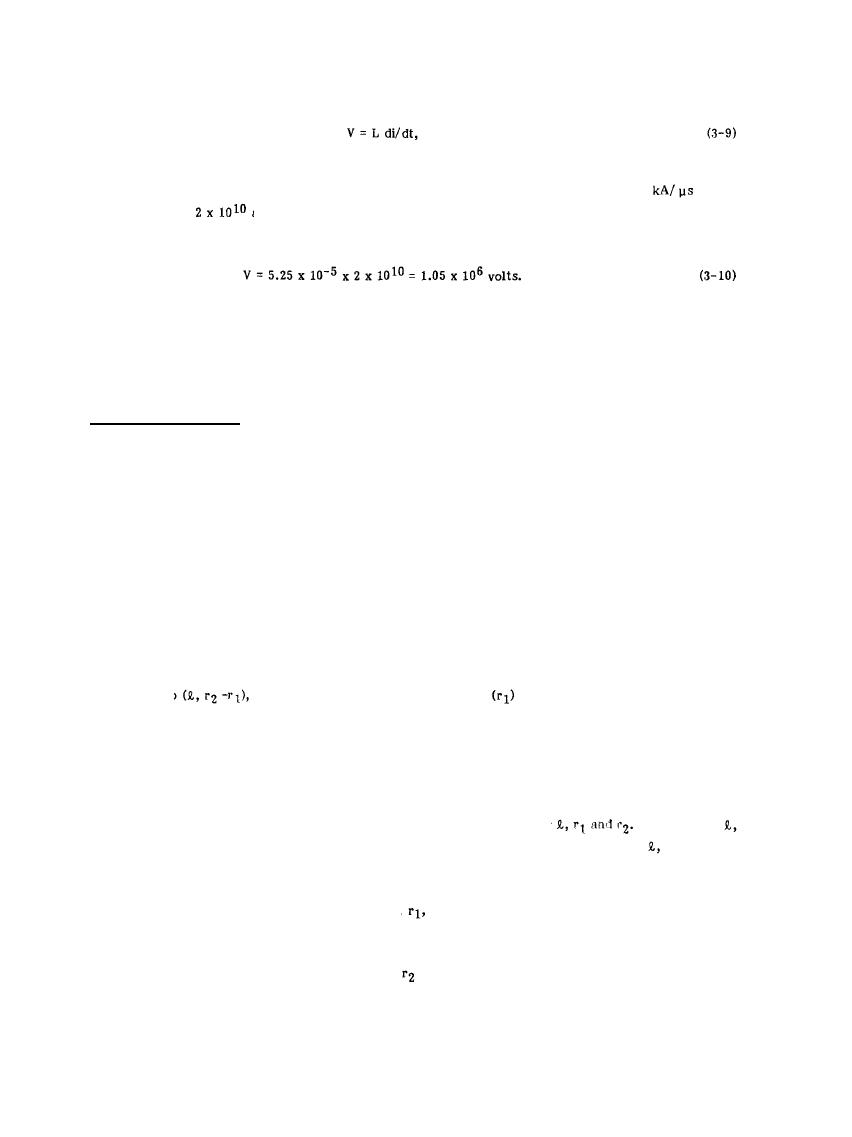

Custom Search
|
|

|
||
 MIL-HDBK-4194
The voltage, V, developed across an inductance is given by
where L is the inductance in henries and di/dt is the rate of change of the current through the inductor in
amperes per second. From Table 3-1, the rate of rise of the typical lightning stroke is 20
which
corresponds to a di/dt of
amps/second. Thus the voltage developed by the discharge pulse through the
30-meter (100 foot) downconductor is
Although the duration of this voltage is typically less than 2 microseconds, the voltage generated is high enough
to cause flashover to conducting objects located as much as 35 cm (14 in.) away from the down conductor. It is
for this reason that metallic objects within 6 feet of lightning down conductors should be electrically bonded to
the down conductors.
3.6.3.2 Induced Voltage Effects.
In addition to the lightning effects discussed above, circuits not in direct contact with the lightning discharge
path can experience damages even in the absence of overt coupling by flashover. Because the high current
associated with a discharge exhibits a high rate of change, voltages are electromagnetically induced on nearby
conductors. Experimental and analytical evidence (3-12) shows that the surges thus induced can easily exceed
the tolerance level of many components, particularly solid state devices. Surges can be induced by lightning
current flowing in a down conductor or structural member, by a stroke to earth in the vicinity of buried cables,
or by cloud-to-cloud discharges occurring parallel to long cable runs, either above ground or buried (3-2).
Consider a single-turn loop parallel to a lightning down conductor such as that shown in Figure 3-9. The
voltage E magnetically induced in the loop is related to the rate of change of flux produced by the changing
current in the down conductor (see Section 6.2.2.1). The voltage induced in the loop is dependent upon the
dimensions of the loop
its distance from the down conductor
and the time rate of change of the
discharge current (di/dt). Figure 3-10 is a plot of normalized voltage per unit length that would be developed in
a single turn loop of various widths.
These results suggest the steps that should be taken to minimize the voltage induced in signal, control, and
power lines by lightning discharges through down conductors. First, since no control can be exercised over di/dt
because it is determined by the discharge itself, E must be reduced by controlling
The variable
is a measure of the distance that the loop runs parallel to the discharge path; thus, by restricting
the induced
E can be minimized. Thus cables terminating in devices or equipments potentially susceptible to voltage surges
should not be run parallel to conductors carrying lightning discharge currents if at all possible. If parallel runs
are unavoidable, Figure 3-10 also shows that the distance,
between the loop and the lightning current path
should be made as large as possible.
Another observation to be made from Figure 3-10 is that
minus r1 should be as close as possible to zero. In
other words, the distance between the conductors of the pickup loop should be minimized. One common way of
reducing this distance is to twist the two conductors together such that the average distance from each
conductor to the discharge conductor is the same.
3-18
|
 
|
|
 |
||